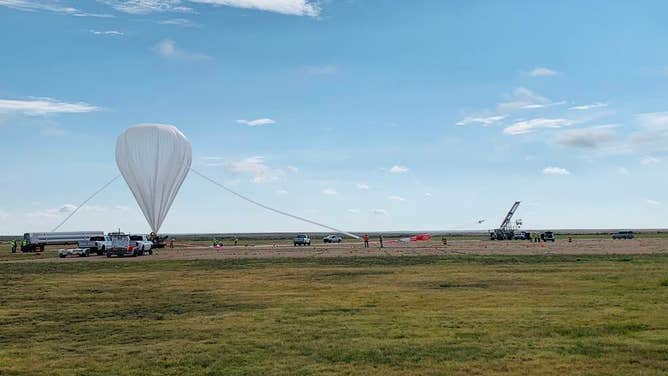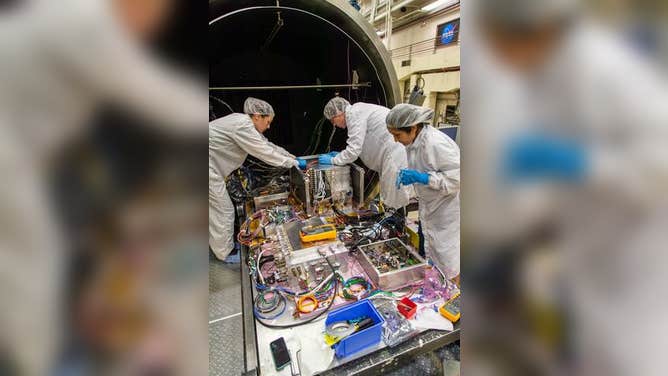NASA scientific balloon launches require forecasting from ground to stratosphere
NASA began the start of its scientific balloon season in New Mexico last week. Missions this year include two instruments studying gamma rays and a NASA telescope looking for Jupiter-size worlds.
New video shows how NASA launched a super balloon from New Zealand
A massive balloon is making its way across the globe, but it is all being done in the name of science. The NASA craft is carrying a Super-pressure Balloon-borne Imaging Telescope (SuperBIT). Researchers say the telescope is capable of taking sharp images of distant galaxies.
FORT SUMNER, New Mexico -- NASA’s scientific balloons can launch instruments weighing about as much as two cars at a fraction of the cost of a rocket launch to low Earth orbit, but first, the forecast needs to be just right.
"It’s pretty complicated," explained meteorologist Robert Mullenax with NASA's Columbia Scientific Balloon Facility in New Mexico. "What we care about in the weather almost nobody else cares about."
The space agency’s Scientific Balloon Program season in Fort Sumner, New Mexico, kicked off in August with the planned launches of 24 science payloads utilizing the giant balloons to reach above the clouds and conduct space observations or test instruments.
Mullenax described the wind conditions for an ideal balloon launch forecast: Surface winds less than 6 knots and winds up to 1,000 feet blowing behind the balloon, so it is pushed up over the launch vehicle when it's released. Ideally, winds between 700 and 1,000 feet are less than 7 knots (8 mph).
Also, no rain, thunderstorms or fog.
"We also can't have any severe visibility restrictions like heavy, dense fog," Mullenax said. "For us, even a drizzle is bad, you know, so a heavy thunderstorm obviously is terrible."
It's no surprise the weather foiled the first two launch days. New Mexico is in the middle of the Southwest Monsoon season, making the forecast difficult.
ACCURATE WEATHER FORECASTS WOULD BE ALMOST IMPOSSIBLE WITHOUT WEATHER BALLOONS
Mullenax explains the program launches balloons from August to October because of the conditions higher than at the cloud level.
"The stratosphere drives pretty much what we do. We try to go to places to launch when the surface weather is good as well, but the stratosphere drives a lot," Mullenax said.

A scientific balloon for the fall campaign is inflated before it will be released for flight in Fort Sumner, New Mexico. (Image Credits: NASA's Wallops Flight Facility)
(NASA)
Forecasters look at the stratosphere winds to ensure the balloons won’t get blown out of the operational flight path, which is restricted to the Mexican border and other boundaries, including the Los Angeles International Airport airspace.
How the stratospheric winds blow will determine the length of a balloon flight and what kind of science payloads they fly.
In August, the stratospheric winds around 90,000 to 160,000 feet are moving west.
"We'll go into western Arizona, get three to maybe seven or 8 hours of flow in August. So we'll take care of our science groups that want shorter flights," Mullenax said.
WHAT ARE THE 5 LAYERS OF OUR ATMOSPHERE?
In September, during a period called turnaround, Mullenax said the Summer anti-cyclone in the stratosphere starts to break down, switching the winds from easterly to westerly heading into fall and Winter.
In the winter, longer flights that don’t go as far are possible.
"The balloon is kind of just around the stratosphere for 24 hours and maybe only be 200 miles away. And then as we get into late September, early October, we start going east with the as the cyclone sets up in the stratosphere, and then we're back to short flights again."
‘Power of the balloon platform’
NASA’s Scientific Balloon Program, managed by NASA's Wallops Flight Facility, has run for 30 years, offering an opportunity for up-and-coming as well as returning scientists.
"The power of the balloon platform for training the next generation of scientists" is vitally important, said NASA Goddard Spaceflight Center astrophysicist Carolyn Kierans.

ComPair principal investigator Carolyn Kierans (NASA, left) and the University of Maryland Baltimore county’s Janeth Valverde Quispe (right) and Nicholas Cannady (back) work on ComPair ahead of thermal vacuum testing at NASA’s Goddard Space Flight Center in Greenbelt, Maryland, in this photograph. (Credits: NASA/Scott Wiessinger)
(NASA)
Kierans learned from flying payloads during her graduate career and now returns as a principal investigator of the Compton Pair (ComPair) mission, one of two gamma-ray instruments launching during this year's New Mexico campaign.
"A student can take a leadership role in one of these things and also see from the beginning concepts of one of these missions to the final stages and have that in the chunk of time of doing a Ph.D.," Kierans said. "It is an extremely unique experience."
The balloon flight will allow ComPair's team to test the instrument in a space-like environment and gather more data to propose a large-scale gamma-ray satellite mission.
Karla Onate Melecio, with the University of New Hampshire, is the graduate student lead for the GRAPE (Gamma-Ray Polarimeter Experiment) Mission. After GRAPE launches, Melecio will be one of the science team members analyzing data in real-time.
Different variations of GRAPE have been ongoing for nearly 20 years.
"The accessibility of missions like this and being able to test these instruments in the timeframe that we can test them in, and then continue to develop them into something that is able to do really amazing science is really the goal here," Melecio said.

A map of Earth with NASA Scientific Balloon launch locations. (Image credits: NASA/Zell)
(NASA)
NASA’s Scientific Balloon Program mission operations manager Andrew Hynous said the program is "roaring back" again after a slowdown during the coronavirus pandemic.
Hynous said the science community appreciates the flexibility of the balloon flights and the real-time data.
"We’re able to do from a short duration up to long duration flights, and you're up above 97% of the atmosphere, and you're able to get the instrument back, which is a huge cost saving because that means that our science community, they're able to fly their missions over and over again," Hynous said. "They're able to take what they had before, build on it, tweak it, improve it, and then go fly it again."
NASA also launches balloons in Texas, Hawaii, Australia, Antarctica and Sweden, and the agency is working on 100-day-long flights from New Zealand. Nine months out of the year there are balloon campaigns ongoing with about 20 missions annually.
Mullenax has been forecasting for the Scientific Balloon Program since 1991 and said you can’t beat it as a meteorologist.
"It's really cool doing a forecast, and then your result is that big 39 million cubic foot balloon comes out of the spool rattling, making all that sound, and you see it launched," Mullenax said. "It’s a really rewarding job."
